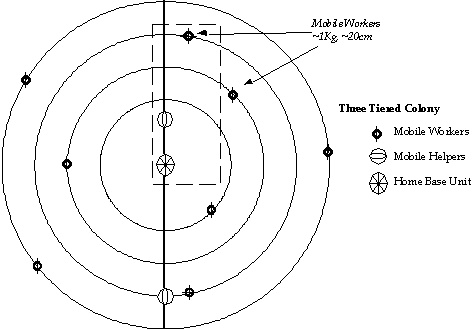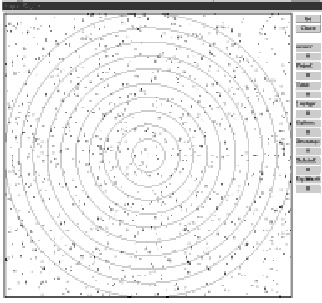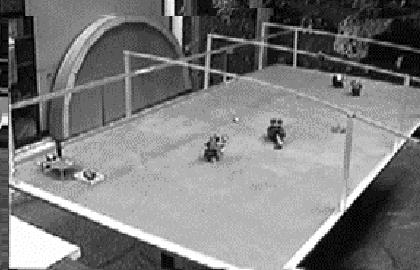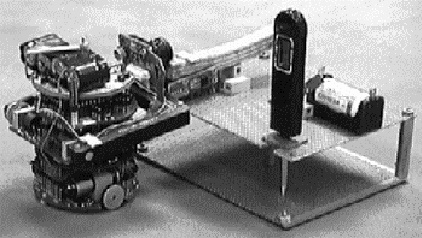Primary Author: Alberto Behar
Abstract
Given current miniaturization trends in robotics, and communications there is now an opportunity to plant "seeds" in space that could bring a reduction in the enormous cost associated with sending human explorers when newly designed small tele-robots could perform the precursor missions. In light of this, our project is to investigate new generations of smaller, networked tele-robots, named SKIT's, for exploring the abundant and rich untapped resources of asteroids. We are performing hardware/software simulation studies to determine the relative merits of using sub-kilogram robots for this type of work. This paper is an attempt to detail a proposed solution and presents a study performed to develop, simulate and evaluate the SKIT concept. Although the requirement of <1 kg for each robot puts forth a challenge to previous modes of thinking, it actually pushes us into new modes where with novel robotic architectures we can benefit from systems that have high coverage, high full-system-level reliability, and low cost.
Keywords: distributed systems, robotic exploration, teleoperation
Introduction
The research included in this paper is motivated by the desire to create an evaluation methodology for multi-agent exploratory systems. A location where results of this type of study could provide enormous benefits is on the surface of the many recently discovered near Earth asteroids. To effectively design such systems it is important to choose parameters correctly. An effective evaluation methodology can aid in this task. In order to devise this methodology we created an environment scenario in which we can devise experiments to test the effects of different parameters on an exploration colony in an effort to obtain a measure of colony performance. Our scenario is to have a team or robots go out on a mission to obtain samples on the surface of a constrained terrain. The sample acquisition represents the important task of gathering information about the environment (i.e. taking images, collecting specimens, etc.). The proposed study is concerned mainly with two aspects of colony design and evaluation not previously researched and their effect on colony efficiency. The two aspects are the population effects in the face of changing environmental parameters and the effects from adding tele-assistance (an operator sending high level commands) to a colony. These aspects are decidedly different from previous studies on colony robots that concentrated on communication, control and cooperation of the colonyís members. The steps taken to devise this methodology will be to: develop a concept for a colony of robots working in a low gravity environment, construct a computer simulation of portions of the concept, use the simulation to determine the effect of colony parameters (population & tele-assistance) on colony efficiency and fin ally validate the simulation results on real robots.
Methodology
This section describes the methodology used to develop and evaluate a novel SKIT concept. It begins with a description of relevant mission objectives, then describes the tradeoff study results. It is followed by the hardware and software simulations being devised and performed to test the final chosen architecture.
Mission Objectives : In order to focus our tradeoff study we begin with a short description of a set of plausible mission objectives related to asteroid exploration. This will then give a context in which the tradeoff study can be described. The primary prospecting objectives for asteroids are surface imagery and a detailed determination of their composition. These diagnostic elements should be measured with sufficient global coverage to determine the scale and extent of chemical heterogeneity. In addition, in order to get samples that are pristine, a drill or some similar tool will be needed.
The following list are important properties needed for the future use of near earth asteroids:
Bulk properties: Size, shape, volume, mass, gravity field and spin state
Surface properties: Elemental and mineral composition, morphology, texture
Internal properties: Mass distribution, possible magnetic field
Environment: Possible near-asteroid gas and dust, solar wind interaction
Payloads useful to determine these properties are:
Essential instruments: Imager (CCD)
Gamma or X-ray spectrometer
Highly desirable: I.R. spectrometer
Magnetometer
Drilling device
Sample collector/analyzer
Mass spectrometer
Tradeoff Study Scope
With the mission objectives in mind, we performed a tradeoff study to produce a novel adequate architecture for a SKIT colony. The purpose of the tradeoff studies was to narrow the number of choices without first analyzing all possible solutions and their interactions. The approach used was based on the Kepner-Tregoe (K-T) decision analysis methodology. The K-T approach uses a set of weighted criteria to compare alternatives by scoring them relative to each other and adding up the weighted scores. The overall study approach consisted of two components, concept synthesis and concept analysis.
Over the past decades, a considerable effort has gone into the design of robots for exploration purposes. This database of information is extremely valuable, but not sufficient. Times have changed, and technology advances have made options that were previously rejected now viable. Because of this desire for creative solutions to robotic designs, concept development was not limited to a mere redesign or modification of existing options, but included an effort to broaden the horizon and search out new ideas. With a substantial range of potential solutions provided in the concept synthesis process, design options were then successively filtered out by the concept analysis process. Initially, evaluation consisted of a process of elimination, where qualitative information was sufficient to filter out many options. Quantitative data on performance were then subsequently utilized to further refine the set of options, and separate the promising from plausible ideas. The most promising concepts were further detailed in design and evaluated by simulation. Because of the limitation on knowledge of asteroidal properties, residual uncertainties remained. Consequently, no exact baseline concept was expected to emerge from the study. Instead, an integrated concept was developed that provided a framework for possible future design concepts suitable for the area which we are concerned, primarily surface work on an asteroid.
Tradeoff Study Results
After an analysis of the requirements, tradeoff spaces were generated and categorized in the following ways: SKIT colony architectures, member task organization, mobility options, attachment options, actuation alternatives, and instrument alternatives. In addition to conceiving the tradeoff concepts some effort was spent creating several simulations in an effort to address concerns and gain understanding of mobility issues in a low g environment. In the end a trade off was performed on three concepts produced for the SKIT Colony Architecture option space. The results from this trade off would then guide the design of the final integrated SKIT concept. Elements from each of the other option spaces (mobility, attachment, actuation, instrument) were included in these architecture concepts where they seemed most appropriate. The colony architectures were then put through the analysis previously determined to rank their functionality. Given the results from the tradeoff study we decided on pursuing what we called the Net of SKITs concept.
Integrated Design - Net of SKITs
This architecture consists of a number of SKITs attached to a common net as shown in Figure 1. A net is used to overcome the severe difficulty of traversal and attachment in low gravity. It can initially be spun out before arrival or spread out once the SKITs are located on the surface.

Figure 1. Net of SKITs Layout
Its size is to be relatively small compared to the asteroid with several attachment points for each ring. It should be noted that this unfurling and attachment can cause severe challenges to designers. The net in turn could provide a mechanism for: anchoring, mobility, communication, power, etc. Since the net layout is a ring of concentric circles the SKITs can traverse long ranges on their ring and also can also converge for tasks requiring more than one. The home base contains tool, instrument and part stores, non-mobile instruments, and sample-return canisters in addition to providing power generation and back to Earth communication. In order to reveal the strengths and weaknesses of the Net of SKITs concept described, a hardware demonstration was developed using a three-tiered colony structure. This structure divides the SKITs into three groups: 1) Mobile workers to provide the needed functionality, 2) Mobile helpers to transport tools and supplies, and 3) Home Base Unit for storage and communication.
SKIT Simulations
To provide results in a manageable time the concept was implemented in software by modifying an existing colony simulator name Sophia [1]. Then a section of the complete net (shown by the dotted line) was constructed. This section contained enough elements of the Net of SKITs concept to represent an adequate subset of the systemís functionality and provide a method in which to perform evaluation experiments.
SKIT Net Simulation Software
In order to perform experiments with a simulated robot colony, a robot colony simulator was used (Figure 2). Entities are displayed on a two-dimensional world. The blocks represent (depending on their color) robots, objects, or obstacles. Values of a number of variables are dynamically displayed on the experiment screen, including the population, total energy, and total performance of a working colony.

Figure 2. SKIT Net Simulation Software
A large number of parameters are used in order for a variety of experiments to be performed. These parameters specify the world, the inhabitants of the world, and the features of the experiments. The world is populated by a colony of robots that can range in size from 1 to 1000 robots. The robots move in the world and perform tasks on the entities, transforming sensory information from the environment in motor behavior. Each robot is able to gather or decompose objects. One of the outputs supplied is the energy consumed by the robot throughout the experiment. This can be summed to look at the total energy consumed by a colony and this parameter gives an indication of colony efficiency.
SKIT Net Simulation Hardware
The physical setup for the SKIT Net Simulation Hardware is shown in Figure 3. You will notice the home base unit in the far, bottom left corner. As you move your attention to the right you will see a Mobile Worker Instrument imaging a Mobile Worker General while it is using a tool (scraper) to remove the surface weathering on a rock.

Figure 3. SKIT Net Simulation Hardware
Towards the back of the picture is a Mobile Worker Device near the object it will drill for a sample. For scale the dimension of the rectangular surface is four by eight feet. Each robot is a little smaller than an average coffee cup. Three Mobile workers and one Mobile helper were built to demonstrate two types of tasks collaborative work and teleoperated sampling. Collaborative work was important due to realization that more could be done with a group of robots if we capitalize on their ability to cooperate. One example of this consisted of moving parts, samples, tools, instruments, batteries, from the central storage location out to the sites where they are ultimately used and back again. These actions included but were not be limited to: traversing the web, picking up tools, instruments and supplies, handing them from a helper to a worker and ultimately have the tools/instruments/materials put to use by the worker at a work site.
Figure 4. is an example of a Mobile Helper (MH). This agent is shown working at the Home Base Unit (HBU) picking up a mobile tool (scraper).

Figure 4. Mobile Helper at Base Station
Next to the scraper is the mobile instrument (thermometer). Behind the thermometer is an example of a battery that can be used to replenish energy to worn out agents. The space under the top surface is used to store samples that have been retrieved. The Mobile Helper consists of a base unit called a Khepera robot manufactured by K-Team in Lausanne, Switzerland. This base unit has the advantage of being small, modular, easy to control and low cost. From the base unit additional functional modules can be added as needed to create the unit that is desired. An interesting aspect of each module is the presence of a dedicated processor that controls all of its own functions. Above the base is the gripper turret that gives the SKIT object manipulation abilities. This ability makes this agent general purpose since it can carry samples, materials, tool, instruments, etc. Above the gripper turret is the radio turret that every SKIT agent has to communicate over UHF frequencies at ~4800 Kilobits/sec. This unit provides the Home Base Unit the ability to send a message to a specific agent or send broadcast messages to all agents at once. The top level turret is the Image Processor. Each unit has one to gather images from a small photodiode array made by VLSI, in Edinburgh, Scotland. This unit is under development and will be a major product of this research.
Conclusions and Future Work
We have developed a simulation-based analysis of the problems and possibilities of using multiple small tele-robots to perform surface exploration of a low gravity environment. In order to evaluate the concept we created an environment scenario in which we can devise experiments to test the effects of different parameters on an exploration colony in an effort to obtain a measure of colony performance. Our scenario is to have a team of robots go out on a mission to obtain samples on the surface of a constrained terrain. The sample acquisition represents the important task of gathering information about the environment (i.e. taking images, collecting specimens, etc.). While there are no energy limits on what the robots use, the energy consumed will be tallied and used to measure colony efficiency. This measure will be included into a figure of merit that is used to compare competing designs and is tied to the colony energy and total number of samples gathered per experiment time. To evaluate various colony designs we plan to perform experiments that vary the parameters of number of robots, number/types of samples and the number of tele-assistance commands sent to the colony. The above experiments are so designed to provide an adequate battery of tests that deal with the effects of colony population and level of tele-assistance on overall colony performance for the stated exploration task.
References
- Agah, Arvin, Sociorobotics: Learning for Coordination in Robotics Colonies, Ph.D. Dissertation, University of Southern California, December 1994.
- Friedman, G. F., "An Expanded Agenda for SSI" , SSI Update, Jan/Feb. 1995, Princeton, NJ.
- Freitas, W., R., Gilbreath, editors, Advanced Automation for Space Missions, Proceedings of the 1980 NASA/ASEE Summer Study held at the Univ. of Santa Clara, Santa Clara, CA
- Gehrels, Tom, Collisions with Comets and Asteroids, Scientific American, March 1996 p. 57.
- Kowal, Charles T., Asteroids: their nature and utilization, Ellis Horwood Ltd., 1988.
- Lewis, J. S., Space Resources: Breaking the Bonds of Earth, Columbia Univ. Press, 1987.
- Maryniak, G., "Self-Replicating Machines for Space.", Space Studies Institute Pub., Princeton, NJ.
- Miller, Dave, Small Robots, Big Missions, 1992.
- OíNeil, Gerard, Space Manufacturing of Nonterrestrial Materials, Volume 1, pp. 77-95 (1982).
